Passed down from my Louisiana born and raised grandmother, this authentic Cajun Gumbo recipe is the real deal! Made with a deep, flavorful roux and your choice of proteins, it only gets better the longer it cooks.

Want to save this recipe?
If you’re from south of the Mason-Dixon line, chances are, you have some pretty strong opinions about gumbo. My family certainly falls into that category — we all confidently agree that my Granny’s gumbo is the best gumbo recipe!
Granny grew up in Louisiana, with her families roots tracing as far back as the 1600’s. Her passion for Cajun food has been passed down through each generation, with a big bowl of gumbo served every Christmas Eve. While she’s shared other Cajun recipes like red beans and rice and dirty rice, I think this gumbo is my all-time favorite.
What Makes This Cajun Gumbo Recipe So Good?
- Rich and Flavorful: With the Cajun ‘holy trinity’ (onions, bell peppers, and celery) and a deep, smoky roux, this gumbo has a rich, soulful, authentic smell and taste.
- Family Recipe: Passed down through generations, this gumbo encapsulates the rich culinary traditions of south Louisiana.
- Feeds a Crowd: The recipe easily serves 8 to 10 adults and can be doubled and prepared in advance as gumbo tastes even better the next day!
- Customizable: Play around with what proteins you use, how spicy you make it, and what layers of flavors you include.
- Freezes Great: My Granny always had a freezer full of Gumbo for whenever we came to visit. It’s just as good reheated!
Test Kitchen Review
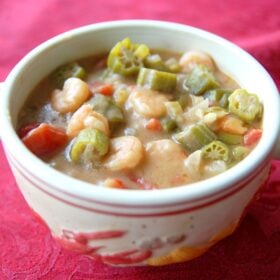
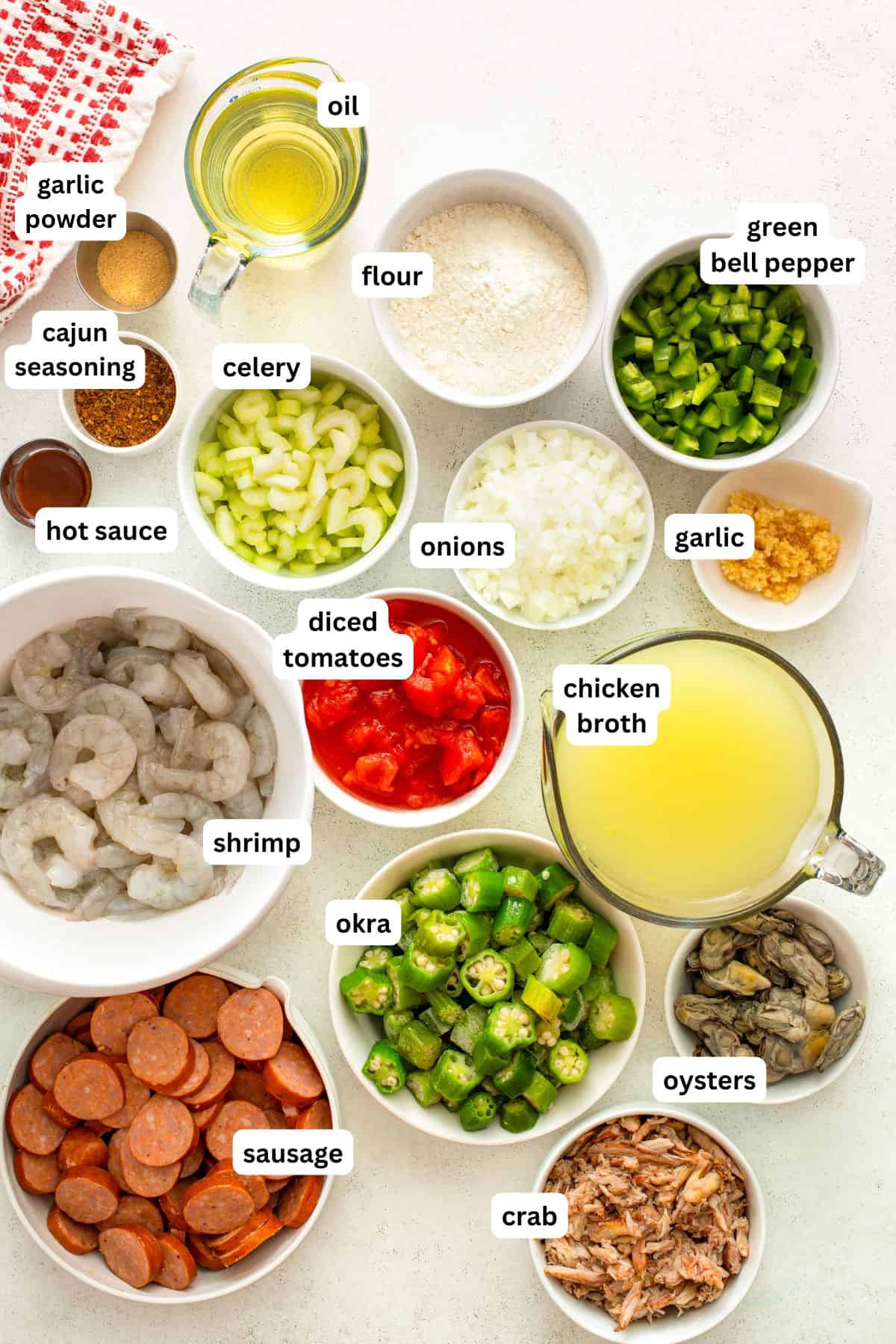
Key Ingredients
Here’s a quick look at some of the key ingredients you’ll need to make real Cajun gumbo. Scroll down to the recipe card below for full ingredient list and exact amounts!
- Flour and Oil: These two come together to create a roux, which is the base of any good gumbo imparting a nutty, robust flavor. Measure both with care — you can’t have too much or too little of either ingredient or the whole thing will be off.
- Holy Trinity: A traditional Cajun trio of vegetables: diced onion, celery, and green bell pepper. My granny dices the celery leaves and includes those for extra flavor.
- Garlic: You can certainly measure the garlic with your heart when making gumbo!
- Stock: You can use seafood stock, vegetable broth, chicken stock, beef stock, or even plain water. Seafood stock is always my preference.
- Okra: Grab it frozen and already sliced to save time. While you can leave it out (my Granny is shuddering right now at the thought), okra is a very traditional addition to gumbo. It helps to thicken the gumbo and also adds flavor and texture. However, you can supplement it with an additional can of tomatoes or extra onion, bell pepper, and celery.
- Diced Tomatoes: While optional, we always add a can of diced tomatoes. They add a savory flavor and the acidity helps to cut back on the sliminess associated with okra. Use the whole can — don’t drain it, the juices add flavor.
- Cajun Seasoning: Slap Ya Mama is my personal favorite store bought version.
Protein Options
- Shrimp: Deveined with the heads and tails removed. Frozen shrimp works perfectly fine, just make sure it’s thawed first.
- Oysters: Fresh oysters are preferred, but you can use canned (making sure to drain them well) in a pinch.
- Crab: We prefer to use lump crab meat, but any crab meat will do. Just make sure to feel the meat with your fingers before adding it, picking out any bones or shell.
- Alligator: Cubed into bite size pieces and sautéed in a skillet with a little oil for a few minutes before adding to the pot. You don’t need to cook it all the way through, but give it a good sear.
- Chicken: Treat chicken the same way you would alligator.
- Sausage: Andouille is my go-to! However, you can use any smoked sausage you like best. I like to sear it in a skillet before adding it to the gumbo for better flavor.
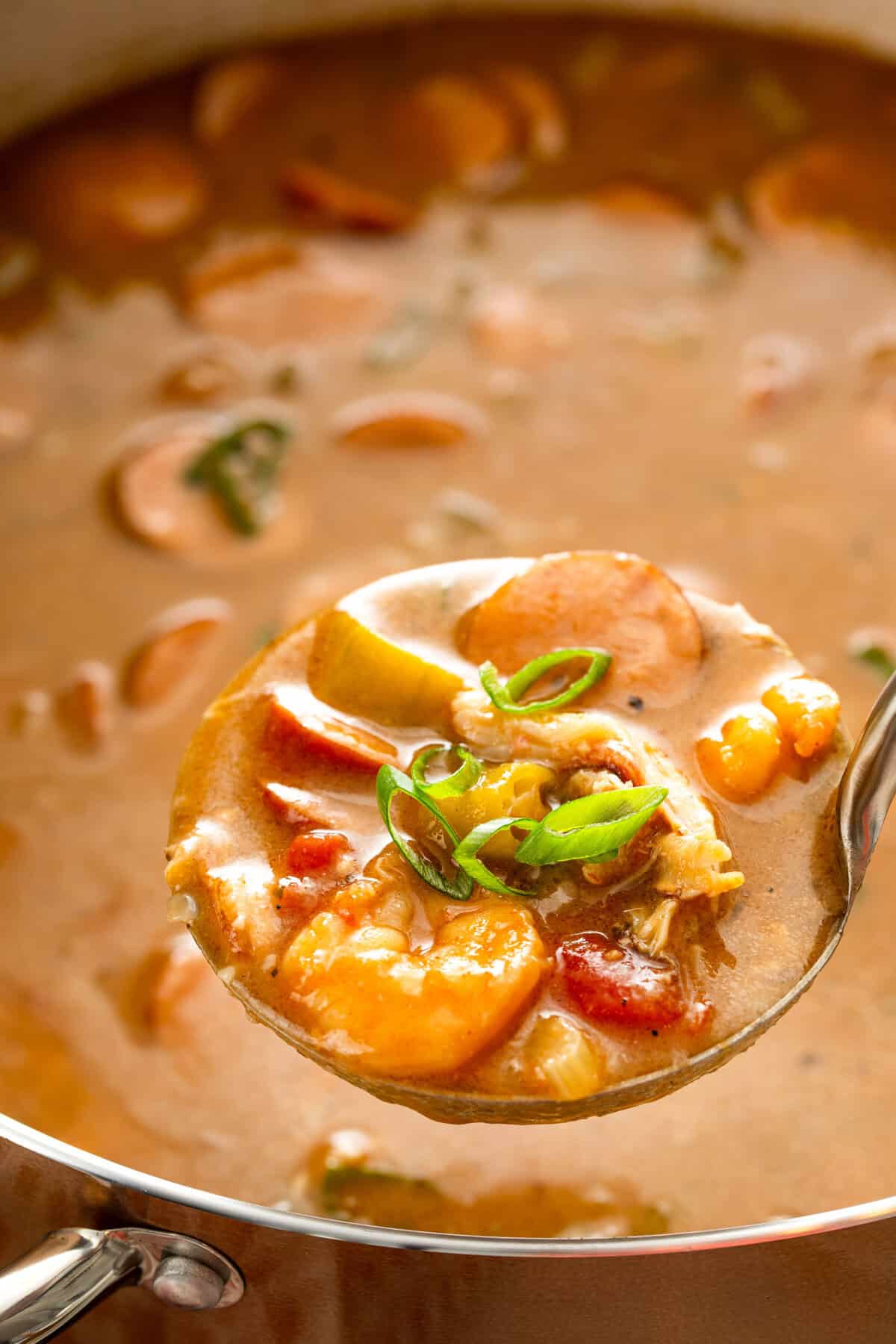
How to Make Gumbo
The key to any good gumbo is really quite simple — don’t burn the roux but get it good and dark brown for lots of flavor. If you burn the roux, toss it out and start over again. You cannot save a burnt roux as it will make the entire batch of gumbo bitter! Below is a quick recipe overview, but please scroll down to the recipe card for full instructions.
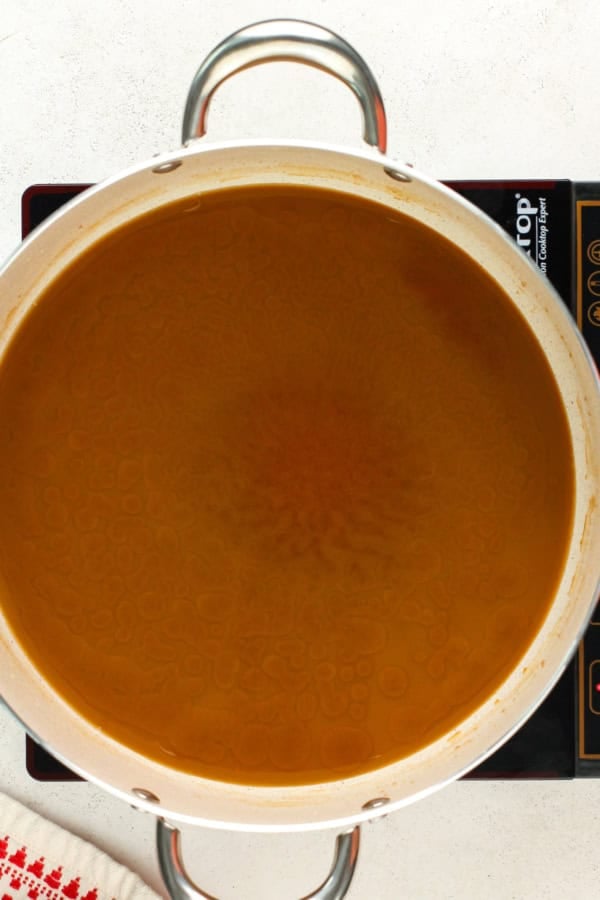
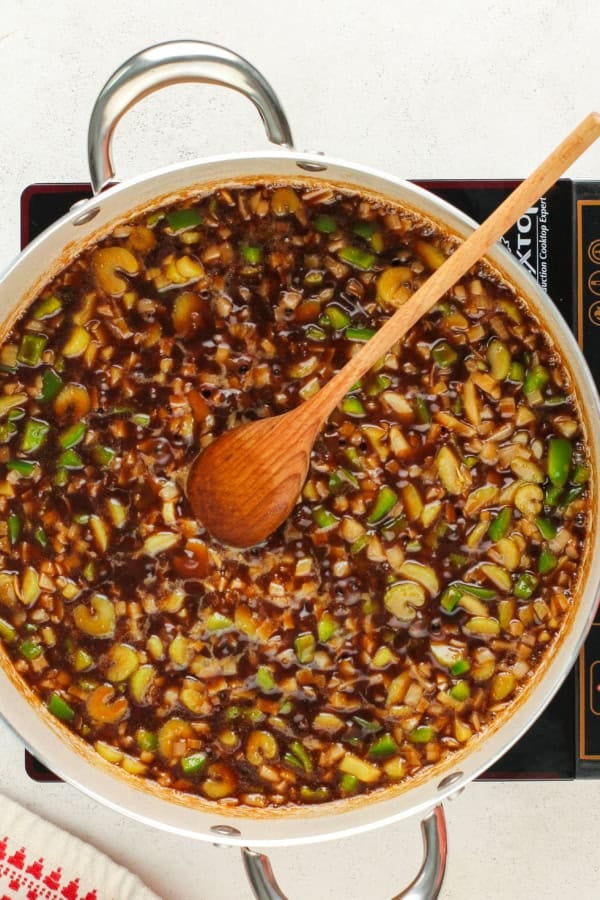
- Make the Roux: Add flour and oil to a big pot. Cook the roux, stirring continuously with a whisk so you don’t burn it! Keep stirring until it turns a dark reddish brown color. This process will take time, about 20 minutes, so don’t try to rush it.
- Add the Holy Trinity: Stir in the onions, bell peppers, and celery. Cook until softened, then toss in the garlic. Lower the heat and add broth (or water) to the pot. Bring to a simmer.

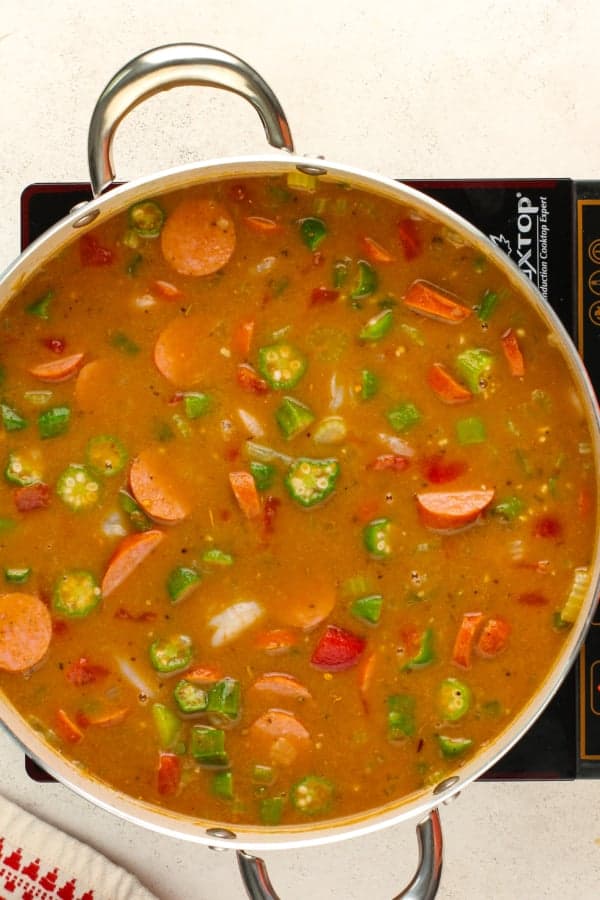
- Cook the Okra: In a separate pan, sauté the okra until soft. Add it to the pot.
- Simmer: Stir in tomatoes, seasonings, and Tabasco. Bring back to a simmer, cover, and cook for an hour or so. Add sausage, chicken, and/or gator, to the gumbo in the last 20 minutes of simmer time.
- Add Seafood: Turn off the heat. Add shrimp, crab, and/or oysters, then put the lid back on the pot and let it sit for about 10 minutes or until the seafood is cooked. While some people add their seafood earlier in the process, my granny always insists we do it this way. Seafood cooks very quickly and can become rubbery if cooked for too long and this method works perfectly every time.
- Serve and Enjoy: Taste and adjust seasonings as needed. To serve, place cooked white rice in a bowl and ladle the gumbo on top.
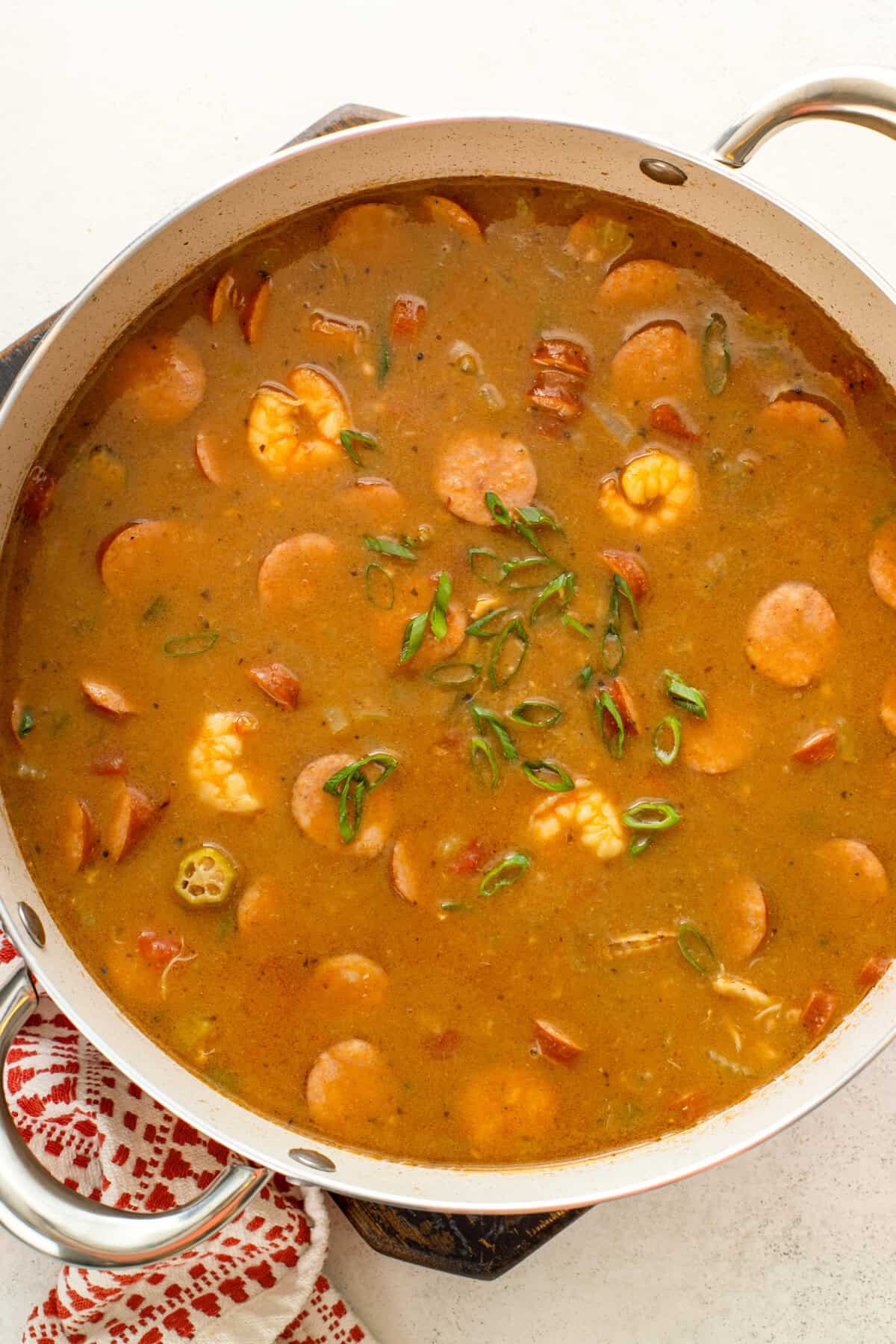
Chef’s Tips & Variations
- The Roux: Don’t walk away from the oil/flour mixture while it’s cooking. It can go from dark brown and perfect to black and burned in a few seconds.
- Don’t Rush the Cooking Time: Gumbo flavors meld and deepen the longer it cooks. Allow at least 1 hour for the flavors to develop fully, but 2 hours is even better.
- Thickness: If the end product is too thick for your taste, thin it to the desired consistency by adding small amounts of additional broth or water.
- Filé Powder: My granny never used filé, but it is common in some families to add it to their gumbo. Filé powder, ground up sassafras leaves, slightly thickens the gumbo and also adds an herbal, earthy flavor. Add up to 2 to 3 teaspoons when you add the other seasonings.

How To Serve Cajun Gumbo
Always serve this Cajun gumbo over a bowl of warm, fluffy white rice. You can also pair it with a side of cornbread (or try my favorite jalapeno cornbread recipe) or crusty French bread. Many of our family members like their gumbo with a side of oyster crackers or saltine crackers as well.
For garnishes, we always set out a bottle of hot sauce and add sliced green onions on top. If you like filé powder, a sprinkle on top right before serving can add an extra layer of flavor.
Authentic Cajun Gumbo Recipe
Ingredients
For the Roux
- 1 ½ cups all-purpose flour
- 1 ¼ cups vegetable oil
For the Gumbo
- 1 large white or yellow onion, diced
- 1 large green bell pepper, seeded and diced
- 1 ½ cups diced celery
- 6 cloves garlic, minced
- 8 to 10 cups low-sodium seafood or chicken broth, or water
- 16 oz frozen sliced okra
- 1 (14.5 oz) can diced tomatoes, or fire roasted diced tomatoes, do not drain
- 3 tablespoons garlic powder
- 3 to 5 tablespoons cajun seasoning, can also add cayenne pepper for more heat
- Tabasco sauce, to taste
Protein Options
- 2 to 3 lbs andouille or smoked sausage, chicken, or alligator, chopped into bite size pieces and seared in a hot skillet with oil
- 3 lbs raw shrimp, deveined, heads and tails removed
- 1 lb lump crab meat, drained
- 8 oz oysters, rinsed and drained
For Serving
- white rice
- green onions, sliced
- Tabasco sauce
- crackers
Want to save this recipe?
Instructions
- In a large heavy bottomed pot, I use a 7-qt dutch oven, over medium-high heat, add the flour and oil. Cook the roux, continuously stirring with a whisk, until it reaches a dark reddish brown color, about 20 minutes. You cannot walk away or stop stirring, otherwise the roux will burn and you will have to toss it out and start all over again.
- After you have gotten your roux to the desired color, add the onion, bell pepper, and celery. Cook, stirring often, until wilted about 7 minutes. Add garlic and cook for 30 seconds more.
- Turn the heat down to low and slowly add broth to the roux, 2 cups at a time. Bring gumbo to a very low simmer, but not a boil. You can decide how much broth you would like to add, but I recommend starting with 8 cups broth. A traditional gumbo should be a little less thick than a bisque style soup. Remember the gumbo still has a while to cook, so you can always add more broth to thin it out later in the process!
- Now, in a separate pan, sauté the okra with oil until it is soft, about 12 minutes. Add the okra to the gumbo. If you are worried about "okra slime" you can place the sautéed okra on a serving plate lined with napkins. Place more napkins on top and lightly press with your hand to remove majority of the oil.
- Add the tomatoes, garlic powder, cajun seasoning, and about 3 tablespoons Tabasco (adding more later to taste). Bring the gumbo back up to a low simmer (bubbling, but not boiling).
- Place the lid on the pot and simmer for an hour (or up to 2 hours), over low heat, stirring occasionally. During the last 20 minutes of your simmer time, add the sausage, alligator, or chicken if using. The longer you let your gumbo simmer, the richer and deeper in flavor it becomes. Remember you can add more broth if your gumbo becomes too thick.
- Add the shrimp, crab meat, and oysters and place the lid back on the pot. Turn off the heat and let the gumbo sit until the seafood is cooked through, about 10 minutes.
- Taste your gumbo and adjust seasonings, as needed, adding extra broth if your gumbo is a little too thick. Serve gumbo over white rice, as desired, with sliced green onions on top. If your gumbo is salty enough and only needs more heat, add more hot sauce or cayenne pepper. Cajun seasoning has a lot of salt in it, so be careful!
Video
Notes
- Store: Transfer leftover cooled gumbo to an airtight container and store in the fridge for up to 5 days. The flavors only get better over time, so this is a great make-ahead dish for hosting dinner or keeping warm in a crockpot for a potluck!
- Freezing: Gumbo freezes beautifully. Allow it to cool completely, then transfer to freezer-safe containers or zip-top bags. Remember to leave a little room in each container for the soup to expand as it freezes. Freeze for up to 3 months.
- Reheating: Reheat gumbo on the stovetop over low heat until warmed through or in the microwave in 30-second bursts, stirring often. If it’s too thick, add a splash of water or broth to loosen it up. If reheating from frozen, thaw in the refrigerator overnight before warming it up for best results.
- Filé Powder: My granny never used filé, but it is common in some families to add it to their gumbo. Filé powder, ground up sassafras leaves, slightly thickens the gumbo and also adds an herbal, earthy flavor. Add up to 2 to 3 teaspoons when you add the other seasonings.
Nutrition
Categories:
More Flavorful Cajun Dinner Recipes to Try
Post may contain affiliate links. Read my disclosure policy.








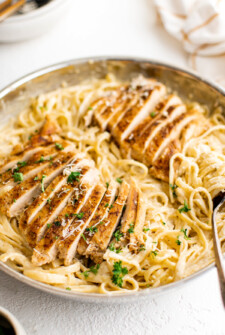
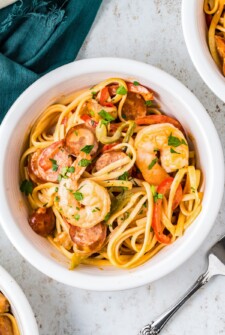
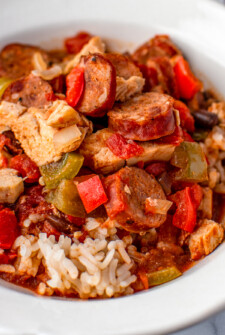
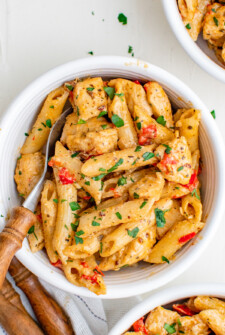

Just like my mom’s!!! This recipe took me back to my childhood and my family can’t wait to have it again!